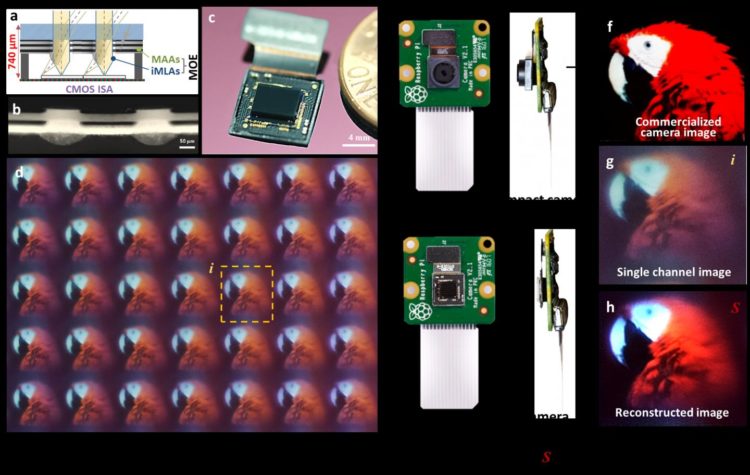
Credit: by Kisoo Kim, Kyung-Won Jang, Jae-Kwan Ryu and Ki-Hun Jeong
An insect’s compound eye has superior visual characteristics such as wide viewing angle, high motion sensitivity, and large depth of field while maintaining a small volume of visual structure with a small focal length. Among them, Xenos peckii, an endoparasite of paper wasps, eyes have hundreds of photoreceptors in a single lens unlike conventional compound eyes with a few light-sensing cells in an individual eyelet. This unique structure offers higher visual resolution than other insect eyes. The Xenos peckii eye also perceives partial images through pigmented cups that block incoming light between eyelets.
Inspired from Xenos peckii eye structure, a KAIST research team led by Professor Jeong Ki-Hun demonstrated a fully packaged ultrathin insect eye camera. They developed a unique and new configuration of micro-optical element to completely suppress the optical noise between microlenses while reducing camera thickness. This optical component was integrated with a complementary metal oxide semiconductor (CMOS) image sensor and the final thickness of fully packaged camera lens is only 740 μm.
The fully packaged ultrathin arrayed camera has successfully demonstrated high contrast clear array images acquired from tiny microlenses. To further enhance image quality of the captured image, they have discussed the vision principle of insect eye and combined the array images into one image through super-resolution imaging. This work also shows the first demonstration of super-resolution imaging, which acquires a single integrated image with high contrast and high resolving power reconstructed from high contrast array images.
“This work reports the first demonstration of ultrathin arrayed camera for high contrast and super resolution imaging. We strongly believe our study will make solely technical advances and also have significant impacts on multidisciplinary communities of micro and nanotechnology mining the smartness from natural photonic structures,” said Jeong.
###
Media Contact
Ki-Hun Jeong
[email protected]
Related Journal Article
http://dx.





